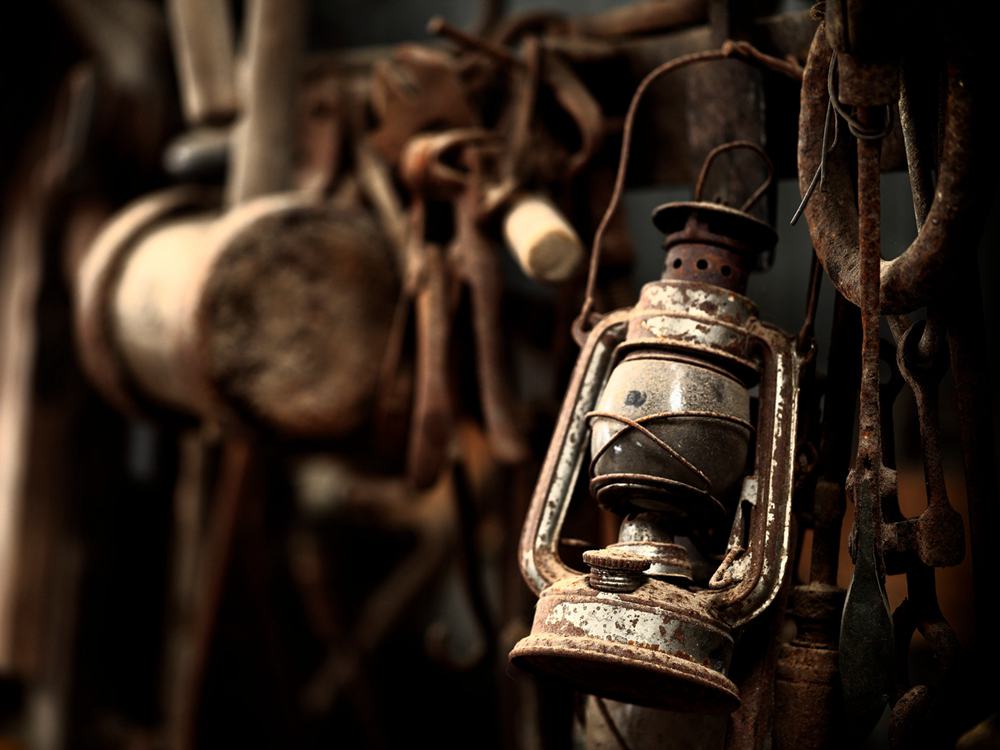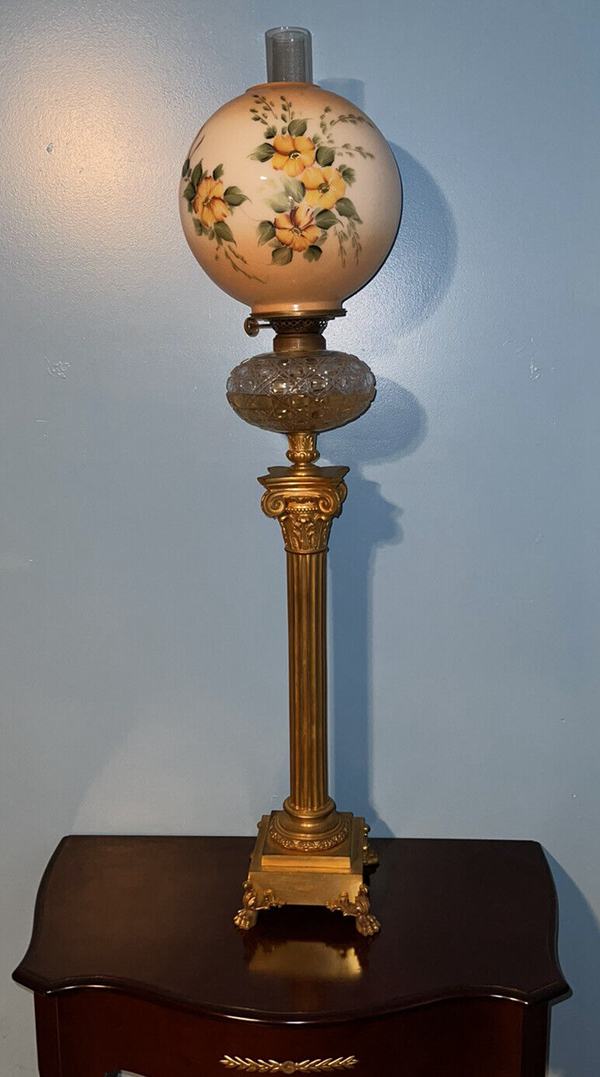Antique oil lamps have been an essential part of our history, illuminating lives for centuries before electricity was available. As a collector or enthusiast, you might be eager to explore the world of these beautiful antiques and learn how to identify them based on their unique features. In this guide, we will provide information to help you in identifying antique oil lamps and understanding their value.
You should keep an eye out for authentic antique oil lamps that have mouth-blown edges, stick-thin stems, wicks, and threaded shafts. Generally, the old and authentic lamps are made of materials like brushed metal, tin, or brass, and they might have warm finishes in copper or bronze. There are four main types of valuable oil lamps to watch for: Cruise, Betty, Central Draught, and Banquet.
When identifying antique oil lamps, you will also need to familiarize yourself with different styles, types of lamp burners, exterior glass colors, production markings, and specific patent details. Moreover, inspecting the lamp hardware can aid in distinguishing between a real antique and antique-styled oil lamp. In the next sections, we will delve more into these aspects to help you develop a comprehensive understanding of the intricacies that make antique oil lamps so fascinating and valuable.
Table of Contents
The History & Evolution of Antique Oil Lamps
When exploring the world of antique oil lamps, you’ll immediately notice that they come in many shapes, sizes, and materials. The history of these lamps dates back to prehistoric times when people first harnessed fire for light. Over time, oil lamps have evolved and have been made from a wide range of materials, such as clay, metal, and glass.
In early civilizations, such as Ancient Rome, Greece, and Egypt, oil lamps were typically made from clay or terracotta. They were simple in design, with a central reservoir for holding liquid fuel and a wick to draw the fuel up for burning. The fuel commonly used was olive oil or animal fat. Some of these early lamps featured decorative embellishments or inscriptions, making them not only functional but also works of art.
As societies advanced and trade routes expanded, the design and materials used for oil lamps evolved. In the Middle Ages, metal lamps became more popular, with intricate designs crafted from bronze, brass, or pewter. Some lamps were even made from precious metals like gold or silver, making them luxury items owned by the elite members of society. The fuels used during this time also diversified, with vegetable oils, fish oils, and even whale oil being utilized.
Lamp designs continued to grow more elaborate in the 18th and 19th centuries, with the introduction of glass lamps. These offered a more refined appearance and allowed for better light diffusion. Some popular styles from this period include the blown glass whale oil lamps and the cut-glass kerosene lamps.
For those interested in identifying and pricing antique oil lamps, consider the following factors:
- Material: Lamps made from valuable materials like gold, silver, or high-quality glass tend to be worth more than those made from more common materials like clay or brass.
- Age: As with any antique, older lamps are generally more valuable. Look for distinguishing marks or features that indicate the lamp’s age or origin.
- Condition: Lamps that are in good condition and still have their original components, such as wicks and burners, will be more valuable than those with damage or missing parts.
- Rarity: Unique designs, limited production runs, or lamps made by well-known manufacturers may demand higher prices.
Remember to consult reputable resources, such as antique dealers and price guides, before making any decisions about the value of antique oil lamps in your collection.
8 Types of Most Valuable Antique Oil Lamps
Argand Lamps
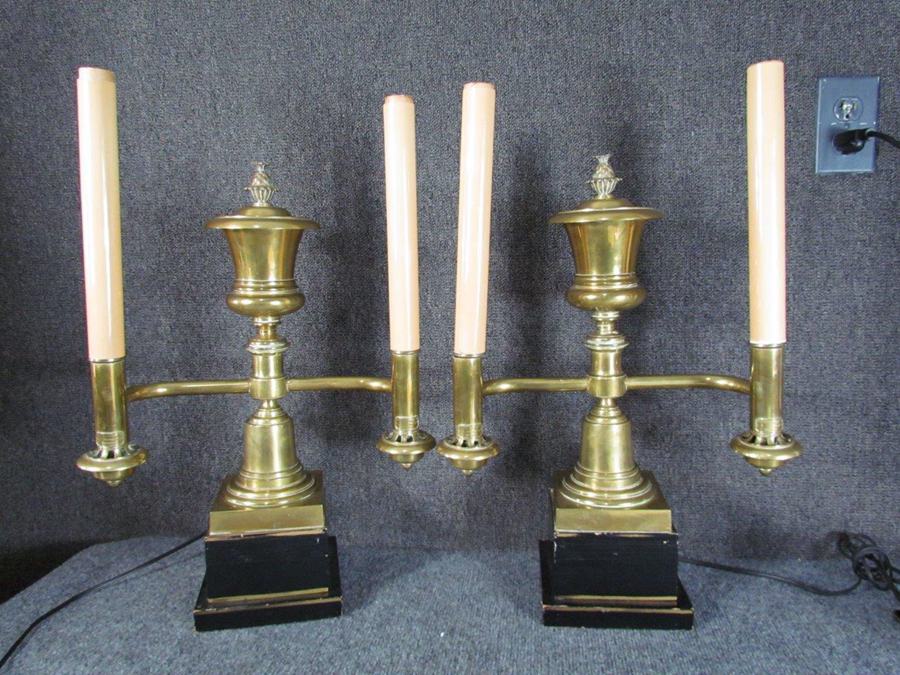
Argand lamps are unique table lamps that were invented by Aime Argand in the late 18th century. These antique oil lamps feature a tubular wick and glass chimney, providing a brighter light than earlier lamps. On average, Argand lamps can be priced around $1,000 to $3,000 depending on their age, design, and condition. A late 18th-century Argand lamp was sold on 1stDibs for $1,800.
Sinumbra Lamps
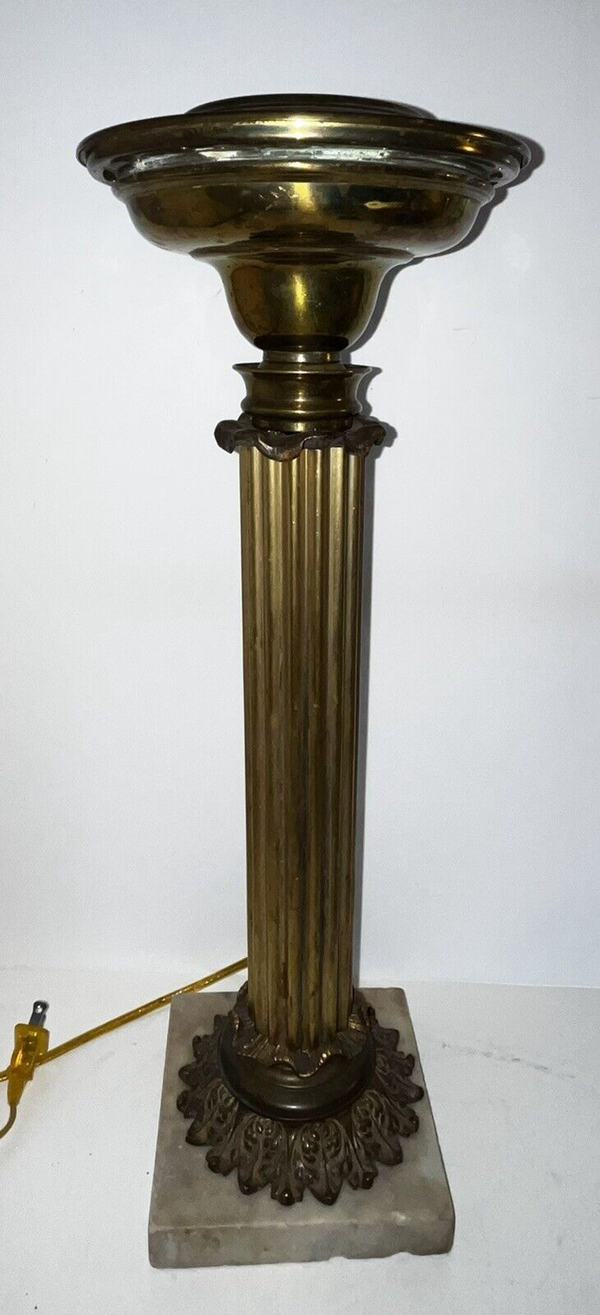
Sinumbra lamps, a variation of Argand lamps, are characterized by their broad, flat wick and distinctive shade, designed to disperse light more evenly. These lamps were popular in the early 19th century, typically used as table lamps or wall lamps. Prices for sinumbra lamps can range from $2,000 to $5,000. An early 19th-century bronze sinumbra lamp was sold at Sotheby’s for $2,500.
Gone with the Wind Lamps
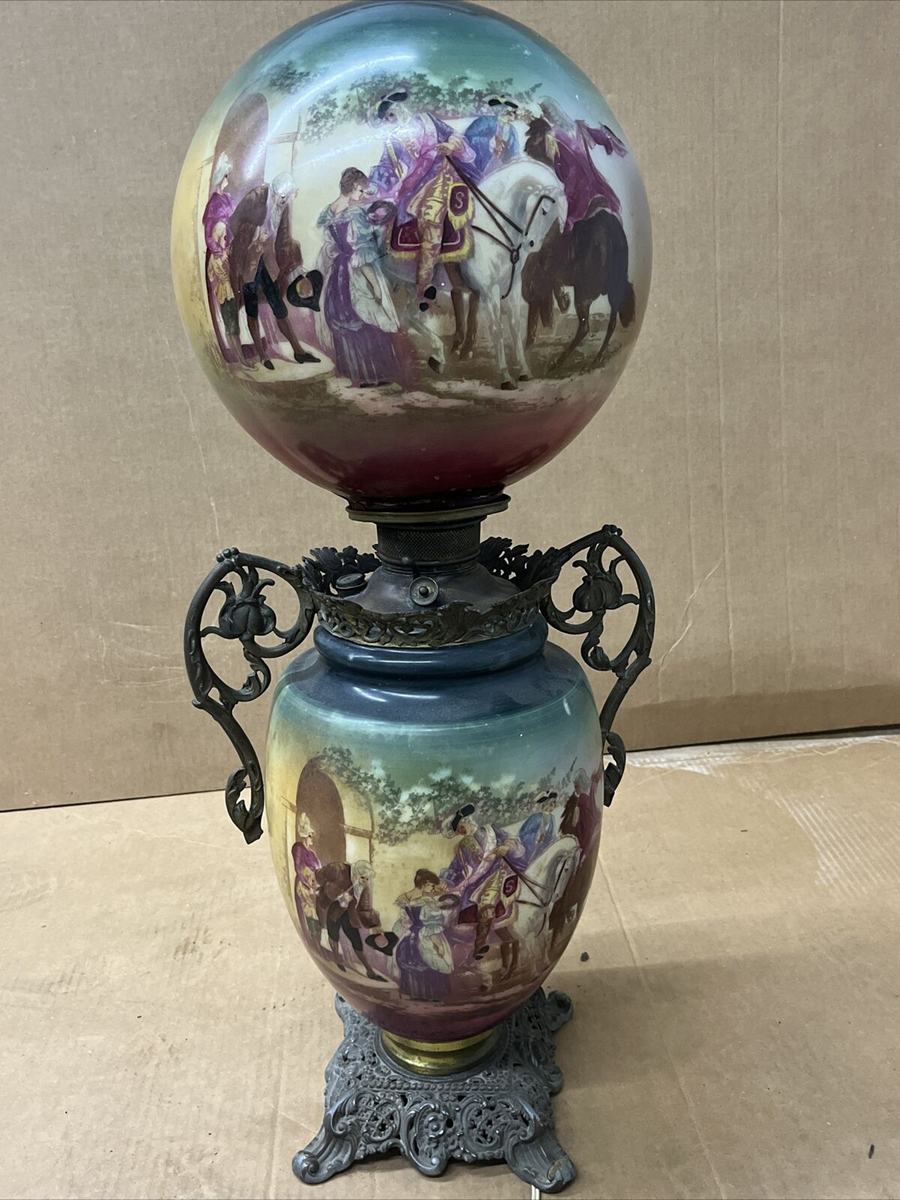
These antique oil lamps feature large, spherical glass globes painted with colorful scenes or intricate patterns, and were popular during the Victorian era. GWTW lamps, as they are commonly known, can be found as table lamps or hanging oil lamps. Their prices vary extensively, from $500 to several thousand dollars, depending on factors such as design, rarity, and condition. A Victorian GWTW lamp with hand-painted roses was sold on eBay for $950.
Solar Lamps
Solar lamps, another variation of Argand lamps, use a different burner mechanism designed to maximize the light output for the amount of oil consumed. These lamps come in either table or wall-mounted styles and are typically priced between $1,000 and $3,000. A mid-19th-century bronze solar lamp was sold at Skinner Auctioneers for $1,200.
Astral Lamps
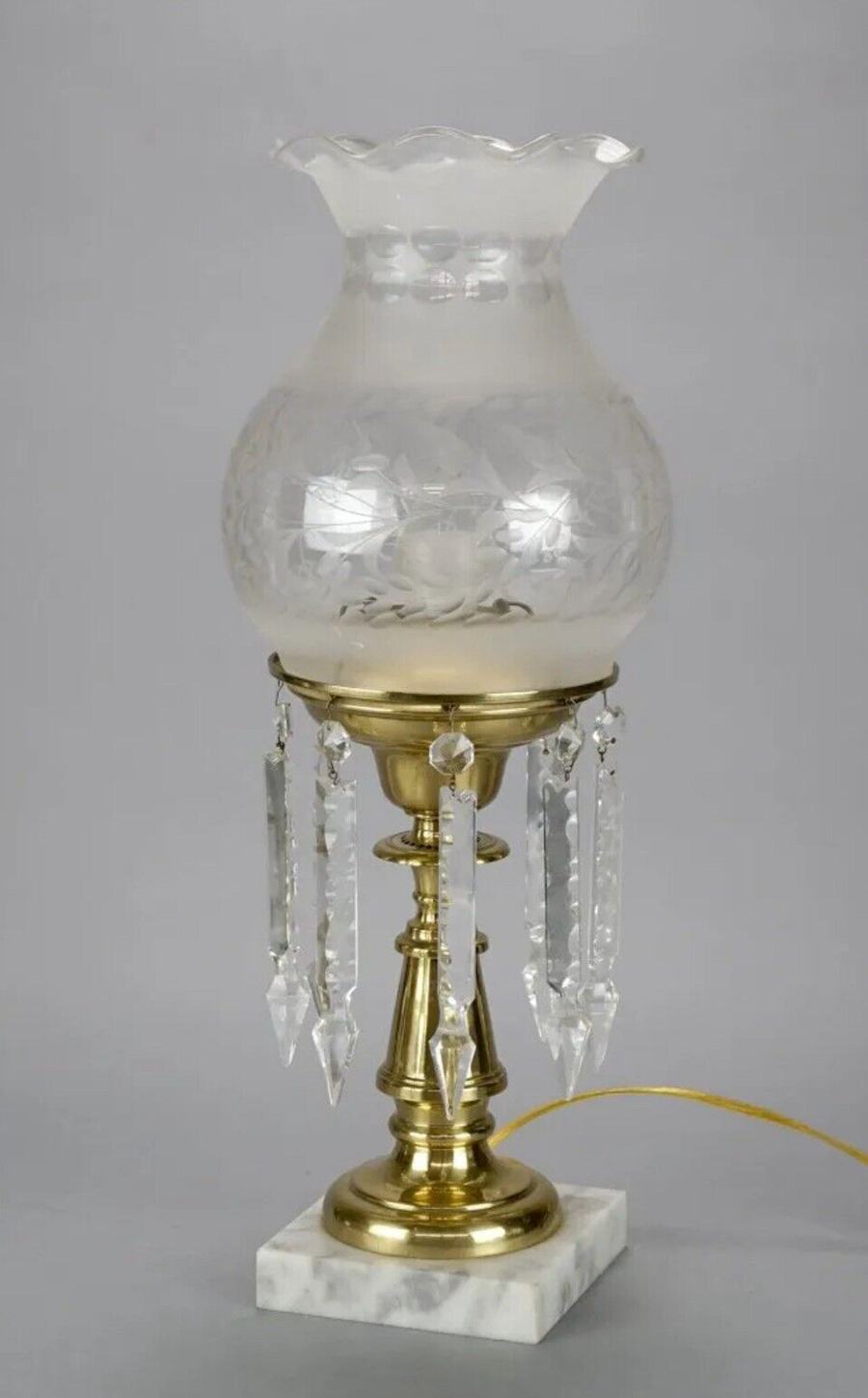
Astral lamps resemble solar lamps, but they have a unique “astral” burner that differentiates them. These antique lamps can also be found as table lamps, wall lamps, or hanging oil lamps. Prices for astral lamps range from $800 to $2,000 depending on factors like age, design, and condition. A pierced brass astral lamp from the 19th century fetched $1,000 at Christie’s auction house.
Tiffany Lamps
Tiffany lamps, named after their creator Louis Comfort Tiffany, are among the most valuable and sought-after lamps, known for their stained glass shades and intricate bronze bases. These are typically table lamps or floor lamps, and their prices can range from a few thousand dollars to over a hundred thousand depending on factors such as rarity, condition, and design. A rare Tiffany “Dragonfly” table lamp was sold at Sotheby’s for $70,000.
Figural Lamps
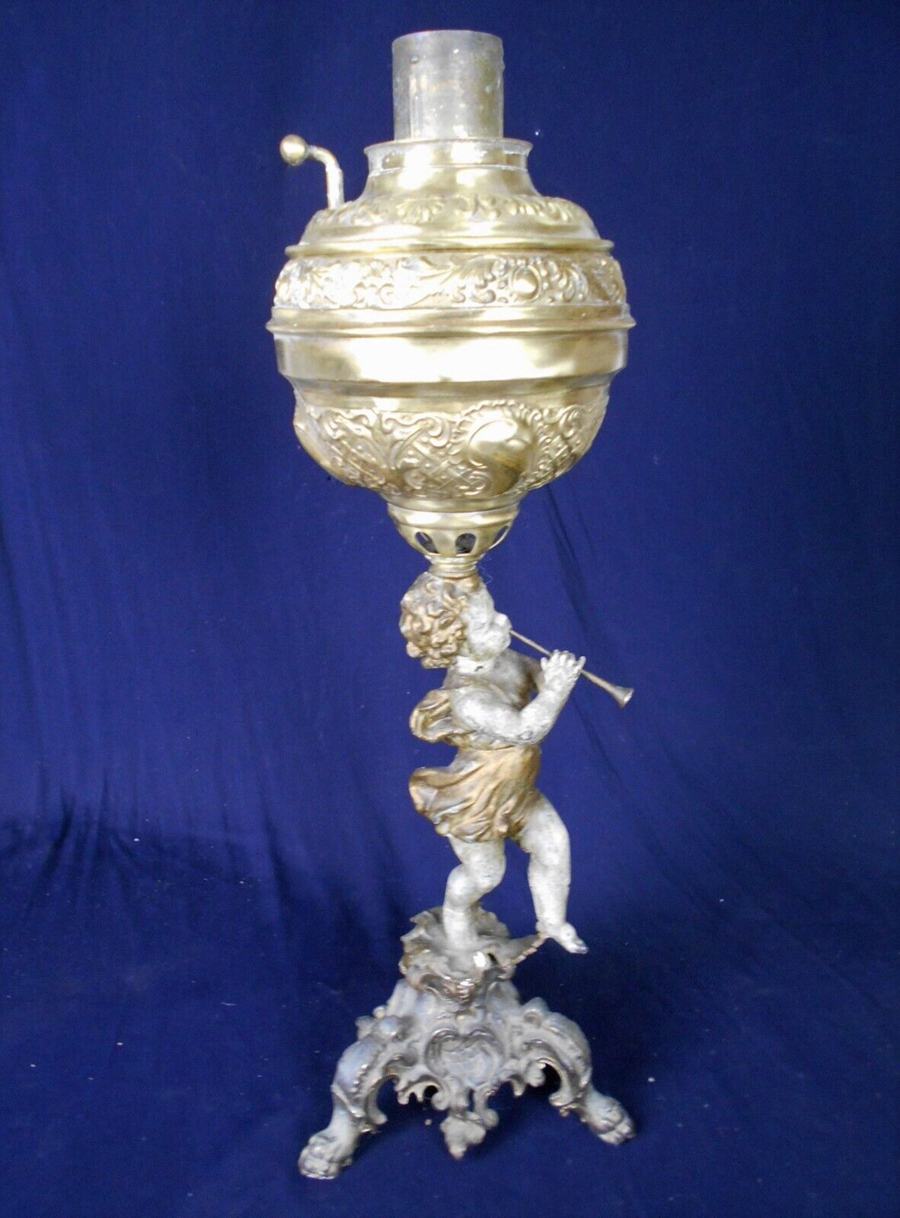
Figural lamps are unique antique oil lamps that feature the shape of a person, animal, or object as part of their design. These can be table lamps, wall lamps, or hanging oil lamps. Prices for figural lamps can be quite variable depending on the intricacy, age, and rarity of the piece. An antique figural banquet lamp featuring a cherub fetched $850 at an auction.
Factors That Affect Antique Oil Lamp Values
1. Maker or Manufacturer
When identifying antique oil lamps, one of the primary factors to consider is the maker or manufacturer. Various manufacturers produced oil lamps, each with its unique style, design, and qualities. To determine the maker or manufacturer of your antique oil lamp, look for any markings, logos, or names on the lamp’s body or the burner.
Some common maker’s marks on antique oil lamps include:
- Aladdin
- New Rochester Lamp Company
- Beacon Light
- Erich and Graetz
In addition, the burner style often indicates the maker of the lamp. Refer to the following valuation table for further guidance on the average value of oil lamps depending on their burner style:
| Burner Style | Average Valuation |
|---|---|
| Flat Wick | $100 – $150 |
| Central Draught | $150 – $200 |
| Argand | $250 – $300 |
| Rochester | $200 – $250 |
| Harvard | $150 – $200 |
Exterior Glass Colors
Antique oil lamps also come in different glass colors, which can affect their value. Check for distinctive colors or patterns, as this may reveal more about the lamp’s origin. Here’s a valuation table based on glass colors:
| Exterior Glass Color | Average Valuation |
|---|---|
| Clear | $100 – $150 |
| Amber | $150 – $200 |
| Blue | $200 – $250 |
| Cranberry | $250 – $300 |
| Green | $150 – $200 |
| Opalescent | $200 – $250 |
Patent Details
Another way to trace the history of your antique oil lamp is by finding a patent number or date. This information is typically found on the burner or the base’s winder button but could also be somewhere else on the lamp. When identifying a U.S.-made lamp, look up the patent number at the United States Patent and Trademark Office. Keep in mind that a patent number can be essential in determining the lamp’s age and, ultimately, its value.
Remember to consult multiple sources and consult experts if unsure about your antique oil lamp’s maker, age, or value. By considering these factors, you can identify and appreciate the origin and worth of your antique oil lamps.
2. Age and Historical Significance
Antique oil lamps have a rich history dating back to the Upper Paleolithic period, when stones with depressions were used to burn animal fats as a light source. The age of an oil lamp plays a significant role in determining its value. Below, you will find a table outlining how age may affect valuation:
| Age of Lamp | Average Valuation |
|---|---|
| Late 1700s – Early 1800s | $500 – 750 |
| Mid-1800s | $400 – 600 |
| Late 1800s | $350 – 500 |
| Early 1900s | $250 – 400 |
When identifying the age of an antique oil lamp, pay close attention to the materials and hardware used. Real antique lamps have metal fitting collars that screw into the burner, font-to-base connections, and metal fitting holes for pouring in oil. The hardware is also typically attached to the lamp with plaster.
Additionally, the patent number or date on the winder button or other parts of the burner or base can help you determine the history of the lamp. You can search for the patent number at the US Patent and Trademark Office to learn more about when the lamp was created and by whom.
The historical significance of a lamp can further affect its value. Lamps with a unique story or provenance, such as being owned by a notable figure or crafted in a specific time or place, may carry a higher value. Be cautious about making exaggerated or false claims, as this can damage your credibility and affect the trustworthiness of your valuations.
Finally, consider the rarity of the lamp style, color, and production markings when determining its value. More uncommon styles, vibrant colors, and identifiable production markings can increase the demand and, subsequently, the value of the lamp. Here is a table to assist you in understanding how rarity affects valuation:
| Rarity Factor | Average Valuation |
|---|---|
| Common Style | $100 – 250 |
| Uncommon Style | $300 – 500 |
| Rare Style | $600 – 1,000 |
| Unique or One-of-a-Kind | $1,500+ |
By understanding the age and historical significance of antique oil lamps, you can better gauge their value and make informed decisions when collecting, buying, or selling these charming relics from the past.
3. Design and Style
When it comes to antique oil lamps, the design and style are crucial factors to consider during identification and valuation. There are various designs and styles available, but a few key aspects can help you determine the age and authenticity of your antique oil lamp.
- Shape: The shape of an oil lamp can indicate its worth. Depending on the shape, the lamps can be classified into three broad categories:
- Pointed, Bulbous, or Natural Shape: These are older and more valuable.
- Planar and Cuboidal: These are mass-produced and cheaper.
- Lotus or Flower Shape: These could be branded and in demand.
- Glass Colors: Antique oil lamps typically have different glass colors, which may hint at their age and origin. Older lamps may have gray or bare metal colors.
Here’s a table with some common lamp shapes and their average valuation:
| Antique Oil Lamp Shape | Average Valuation |
|---|---|
| Pointed or Bulbous | $600 – 700 |
| Natural Shape | $800 – 900 |
| Planar and Cuboidal | $300 – 400 |
| Lotus or Flower | $1000 – 1200 |
- Markings: Examining production markings, such as patent numbers or dates, is another way to identify antique oil lamps. You can often find these details on the winder button, burner, or base of the lamp. Once you locate a number or date, research it at the appropriate patent office to learn more about its history.
- Styles: Antique oil lamps come in various styles, each corresponding to a specific time period. For example, the center draft lamp, which used a cylinder-shaped wick and was popular in the 1700s. Knowing the popular styles of each century can help you locate antique oil lamps more accurately.
Keep these factors in mind when examining antique oil lamps. Proper identification can ensure that you are aware of their value and make informed decisions regarding their purchase, sale, or preservation.
4. Materials and Construction
When identifying antique oil lamps, it’s essential to look at the materials and construction used in their making. This will not only help determine their authenticity but also give you an idea of their value.
Metals Used
Antique oil lamps commonly used metals such as brass, tin, copper, or bronze. Each metal brings its unique characteristics and finishing to the lamp. For instance, brushed metal, tin, or brass lamps may offer better returns, while copper or bronze lamps provide a warm finish.
Glass Colors and Production Markings
Pay attention to the exterior glass colors and production markings on the oil lamp as well. These may indicate the manufacturer or production period, which affects the lamp’s value.
Differences Between Antique and Modern Oil Lamps
In addition to materials, there are notable hardware differences between antique and modern oil lamps. Antique lamps typically have a metal fitting collar that screws into the burner, a metal font-to-base connection, and metal fitting holes for pouring oil. Genuine antique lamps also often use plaster for attaching hardware instead of the glue found in modern lamps.
Valuation Table
Below is a valuation table indicating the average values of antique oil lamps categorized by construction type:
| Oil Lamp Construction | Average Valuation |
|---|---|
| Mouth-Blown Edges | $400 – $500 |
| Stems with Wicks | $350 – $450 |
| Threaded Shafts | $600 – $700 |
| Cruise Style | $450 – $550 |
| Betty Style | $500 – $600 |
| Central Draught Style | $300 – $450 |
| Banquet Style | $250 – $350 |
By analyzing the materials and construction of the antique lamp you have, you can better understand its value and make informed decisions when buying or selling. Keep in mind that the actual value of your antique oil lamp may vary depending on additional factors such as its condition, age, and rarity.
5. Condition
When assessing the value of antique oil lamps, the condition is an essential aspect. The better the state of the lamp, the higher its value. In this section, you’ll find several factors affecting the condition and a valuation table illustrating the impact on an antique oil lamp’s price.
The factors that influence a lamp’s condition include:
- The presence of chips or cracks in the glass
- The integrity of the metal fittings
- The functionality of the burner
- The presence or absence of any missing parts
It’s important to carefully inspect your antique oil lamp for its overall condition before determining its value. Use this valuation table to help you understand how the condition affects pricing:
| Condition Factors | Average Valuation |
|---|---|
| No chips, cracks, or missing parts | $600 – 750 |
| Minor chips or cracks | $450 – 550 |
| Major chips or cracks | $300 – 400 |
| Missing or damaged metal fitting(s) | $200– 300 |
| Non-functional burner | $100 – 200 |
| (Missing parts, severely damaged) | $50 – 100 |
Keep in mind that these prices are just average valuations. The actual value of an antique oil lamp may vary depending on other factors, such as the lamp’s age, shape, color, brand, rarity, and the style of its burner and anchoring system. Consult an expert in antique oil lamps for a more accurate estimation, and use this information as a starting point in your evaluation process.
6. Rarity and Scarcity
When it comes to antique oil lamps, rarity and scarcity play significant roles in determining their value. Factors such as the hanging style, type of lamp burner, and exterior glass color can help you identify and assess the worth of these unique pieces.
Hanging Styles
Hanging styles are essential in identifying the age of an antique oil lamp. Here’s a quick guide on various hanging styles and their corresponding average valuations:
| Hanging Style | Average Valuation |
|---|---|
| Thick handles and finger loops | $450 – $500 |
| Chains or inbuilt grooves | $300 – $350 |
| Welded plates and reflectors | $100 – $150 |
Lamp Burners
Lamp burners are another essential factor to consider when identifying antique oil lamps. Here’s how different types of lamp burners affect the value of these lamps:
| Lamp Burner Type | Average Valuation |
|---|---|
| Rope burner | $400 – $500 |
| Double-wick burner | $350 – $400 |
| Central draught burner | $300 – $350 |
Exterior Glass Colors
The exterior glass color of an antique oil lamp can serve as a good indicator of its scarcity and value. The rarer and more vibrant the glass color, the higher the lamp’s worth. Here’s a guide on various glass colors and their associated valuations:
| Glass Color | Average Valuation |
|---|---|
| Clear | $200 – $250 |
| Blue | $350 – $400 |
| Green | $400 – $450 |
| Purple | $500 – $600 |
Keep these factors in mind as you assess the rarity and scarcity of antique oil lamps, ensuring that you can make informed decisions when purchasing or appraising these unique pieces.
7. Provenance and Historical Associations
When researching an antique oil lamp’s history, it is vital to consider factors such as provenance and historical associations. Provenance refers to the origins or history of ownership of an item, while historical associations are links to important events or famous people connected with the item.
It’s crucial to keep accurate documentation for your antique oil lamp, as this can significantly impact the value. Authenticating the oil lamp can be done by investigating its unique characteristics that provide clues about its age and manufacturer:
- Antique Lamp Styles: Oil lamps from various periods have distinct designs that sometimes indicate their age or place of origin. For example, Greek oil lamps from the 16th Century AD were hand-molded from earthen or stone materials and featured thicker walls, funnel-shaped tubes, and jade or teak wood caps. As you study the style, consider whether the design reflects a certain era or region.
- Types of Lamp Burner: Burner types can also help date an antique oil lamp. Early models often used simple wick systems, while later designs may have more complex burner mechanisms.
- Exterior Glass Colors: The glass color of the antique oil lamp can hint at its age. Some colors, like opalescent and cranberry glass, only appeared during certain periods in history.
To better understand antique oil lamp valuation, refer to the table below for a rough estimate:
| Lamp Age/Type | Average Valuation |
|---|---|
| Greek Oil Lamps (16th Century AD) | $400 – $450 |
| Commercial Lanterns (1700s) | $200 – $250 |
| Georgian/Victorian Glass Lamps (1800s) | $150 – $200 |
| Kerosene Lamps (Early 20th Century) | $100 – $150 |
| Contemporary Reproductions of Antique Lamps | $50 – $100 |
Keep in mind that the average valuations may vary based on factors such as condition, rarity, and documentation of provenance. It is essential to research your antique oil lamp thoroughly and consult with experts or appraisers for a more accurate valuation.
8. Demand and Market Trends
The demand for antique oil lamps has grown as collectors, historians, and interior designers increasingly appreciate their beauty and history. As you start to familiarize yourself with oil lamps, you will notice that there are four main types: Cruise, Betty, Central Draught, and Banquet. Each of these types carries a specific value, depending on factors such as the lamp’s material, condition, and rarity.
Here’s a valuation table to help you understand the average values of antique oil lamps based on their type:
| Type of Oil Lamp | Average Valuation |
|---|---|
| Cruise | $50 – $100 |
| Betty | $80 – $150 |
| Central Draught | $100 – $300 |
| Banquet | $200 – $600 |
To delve deeper into the factors that affect the value of antique oil lamps, it is essential to comprehend the various exterior glass colors, types of lamp burners, and production markings. All these aspects contribute to the overall value, so keeping an eye on these details will prove invaluable for your investments.
In terms of market trends, rare and unique lamps are usually in higher demand. For example, lamps with cut crystal shades, unusual colors, or intricate designs often attract attention. Collectors are particularly interested in oil lamps made by specific manufacturers, as they may hold a prestigious historical and cultural significance.
As you explore the world of antique oil lamps, do remember the importance of authenticity and condition when evaluating value. Many reproductions are circulating in the market, so being able to identify the real deal will save you time and resources. By having a broad understanding of the factors affecting value, you can better navigate the market and make well-informed decisions in your buying and selling endeavors.
Final Thoughts
When it comes to identifying antique oil lamps, paying attention to certain details can be crucial in determining their authenticity and value. Keep the following tips in mind as you examine potential antique oil lamps:
- Look for antique lamp styles and designs that are indicative of the time and region the lamp was produced. Common styles include pointed, bulbous, and natural shapes, as well as designs featuring lotus or flower motifs.
- Examine the lamp’s hardware. Genuine antiques will have metal fitting collars, font-to-base connections, and metal fitting holes for oil. Additionally, antique lamps used plaster to secure parts together, while modern reproductions typically utilize glue.
- Be mindful of exterior glass colors and production markings, as these can provide important clues about the lamp’s age, origin, and potential value.
- Finally, consider using a blacklight to help differentiate between true antiques and modern reproductions, as many authentic antique lamps will appear differently under ultraviolet light.
As you navigate the world of antique oil lamps, keeping these tips and tools handy will help you make informed decisions when it comes to purchasing or selling these stunning pieces of history.
FAQ
What features can help me identify an antique oil lamp?
To identify an antique oil lamp, pay attention to the following characteristics:
- Glass thickness and shape: A central draught lamp from the 1800s, for example, would have thick glass with a bulbous shape.
- Carrying handle or finger loop: Look for a handle or loop on portable lamps that could be carried around.
- Hanging loop: Some lamps have a hanging loop, which allows them to hang level on a wall or nail.
- Production markings: Manufacturer’s marks can be found on the glass covering. These marks help identify the lamp’s origins.
Which specific parts should I check for when identifying antique oil lamps?
When identifying an antique lamp, examine these elements:
- Metal fitting collar: This collar screws into the burner and is present on genuine antique lamps.
- Font-to-base connection: Real antique lamps have a metal connection between the font and the base.
- Oil filling holes: Authentic antique lamps have metal fitting holes for oil pouring.
- Attached hardware: Antique lamps have hardware attached to the lamp with plaster.
How do I determine the value of an antique oil lamp?
To determine the lamp’s value, consider the following factors:
- Condition of the accessories: A well-preserved lamp with functional parts usually fetches a higher price. Broken or missing pieces will contribute to a depreciated value.
- Rarity: Rarer lamps can command higher prices due to their scarcity.
- Aesthetic appeal: Lamps with unique and artistic designs can hold higher value than those with a simpler appearance.
What is the price range for antique oil lamps?
The price of antique oil lamps varies depending on factors such as rarity, condition, and design. As a general guide, the Central Draught Lamp from the 1800s, for instance, has been known to fetch between $140 and $150.

